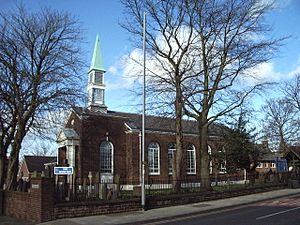Stand, Greater Manchester facts for kids
Quick facts for kids Stand |
|
|---|---|
 Stand Unitarian Chapel |
|
| OS grid reference | SD794055 |
| Metropolitan borough | |
| Metropolitan county | |
| Region | |
| Country | England |
| Sovereign state | United Kingdom |
| Post town | MANCHESTER |
| Postcode district | M45 |
| Dialling code | 0161 |
| Police | Greater Manchester |
| Fire | Greater Manchester |
| Ambulance | North West |
| EU Parliament | North West England |
| UK Parliament |
|
Stand is a quiet residential area. You can find it in Whitefield, Greater Manchester, England. Its name comes from a "hunting stand." This was a place where people could stand to look for animals in the countryside.
Contents
Discovering Stand's Past
Stand has a long and interesting history. Many important buildings and stories come from this area.
Stand's Old Halls
The original building was called Stand Old Hall. It was built on the highest spot in Whitefield. From here, people could see the Pilkington Deer Park. This park is now where Stand Lane and Ringley Road meet. Stand Old Hall was the main house for the Pilkington family. They were the lords of the area called Pilkington and Bury.
Around 1515, a new building, Stand Hall, replaced the old one. This happened after the Earl of Derby took control of Pilkington. The old hall was then used as a barn. Later, in the 1800s, it became a cowshed. Sadly, the old hall fell apart. It was taken down in the early 1960s.
All Saints' Church
You can find All Saints' Church on Church Lane. It is a very old and important building. It was designed by a famous architect named Charles Barry. The church was built between 1821 and 1826. It is now a Grade I Listed Anglican parish church. This means it is protected because of its special history and design.
The Story of Stand Grammar School
Stand Grammar School started in 1688. It was created thanks to the will of Henry Siddall. The school had strong ties to the Unitarian Chapel on Ringley Road.
In the early 1900s, the school faced money problems. So, in 1908, the Lancashire Education Committee took it over. A new school building was built on Church Lane. This new school opened on September 6, 1913. It was built on a large piece of land bought from the Earl of Derby.
The school taught both boys and girls for a while. But in 1937, a separate girls' school opened on Higher Lane. The boys' school kept growing. It had 700 students at one point. Eventually, it became part of Bury College. The old school building was taken down in 2001.
Robert Clive: A School Mystery
Some people think that Robert Clive went to Stand Grammar School when he was young. Robert Clive was a very important figure in British history. People started trying to connect him to the school around 1907.
Sir Colvin Bayley, who was related to Clive, said that he heard Clive had attended the school. This was before Clive lived in Hope Hall in Eccles. However, this link has been questioned. There are no official records that say Robert Clive went to Stand Grammar School. Even Sir Colvin Bayley admitted this.
Despite the lack of proof, a group called the Old Standians' Association honored him. In 1913, they put up a bronze plaque. They also named one of the school's houses after him.
Stand's Modern Connections
Stand continues to be a place where interesting things happen.
Music and Schools Today
Some members of the alternative rock band Elbow met in the 1990s. They were studying at Stand College at the time.
Stand Grammar School for Girls, which was on Higher Lane, was later renamed Philips High School. Today, Philips High School is a comprehensive school. It is also a special college for maths and computing.


